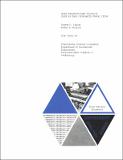Heat transfer and pressure drop in tape generated swirl flow
Author(s)
Lopina, Robert F.; Bergles A. E.
DownloadHTL_TR_1967_047.pdf (7.002Mb)
Other Contributors
Massachusetts Institute of Technology. Dept. of Mechanical Engineering.
Massachusetts Institute of Technology. National Magnet Laboratory.
Massachusetts Institute of Technology. Heat Transfer Laboratory.
Metadata
Show full item recordAbstract
The heat transfer and pressure drop characteristics of water in tape generated swirl flow were investigated. The test sections were electrically heated small diameter nickel tubes with tight fitting full length Inconel tapes of twist ratios from 2. 48 to 9. 2 inside diameters/180 of tape twist. Heat transfer coefficients and friction factors were determined for non-boiling forced convection heating and cooling while overall pressure drop information and curves of heat flux versus wall superheat were determined for surface boiling conditions. Improvements in heat transfer for equal flow rates of up to 851c were observed for the non-boiling swirl flows with heating, but the improvement with cooling was substantially less. Compared on the basis of equal pumping power, improvements in heat transfer of up to 351c were observed for the tighter tape twists. A method for predicting the heat transfer coefficient for non-boiling swirl flows was developed. It was based upon the theory that the improvement was due primarily to: 1) the increased flow path created by the tape, 2) the increased circulation created with heating due to the buoyancy effect set up by the large centrifugal force present, and 3) the fin effect of the tape. The experimental results of this and previous swirl flow investigations were in good agreement with the analytical prediction. The surface boiling characteristics of swirl flow were found to be similar to those observed in straight flow. The boiling curves for various velocities were asymptotic to a fully developed line at high wall superheats, and the visually observed point of incipient boiling and the transition to the fully developed boiling asymptote were predictable by conventional straight flow methods. It was concluded, therefore, that the dominant surface boiling heat transfer mechanism was similar for both swirl and straight flow. (cont.) For non-boiling swirl flows, the decrease in the pressure drop with heating was slightly less than is usual with straight flows, while the increase in the pressure drop with surface boiling was substantially less. A method for predicting the difference in each case is presented.
Date issued
1967Publisher
Cambridge, Mass. : M.I.T. Dept. of Mechanical Engineering, [1967]
Other identifiers
14089950
Series/Report no.
Technical report (Massachusetts Institute of Technology, Heat Transfer Laboratory) ; no. 47.
Keywords
Heat -- Transmission., Pressure -- Measurement., Tubes -- Fluid dynamics., Boiling-points.